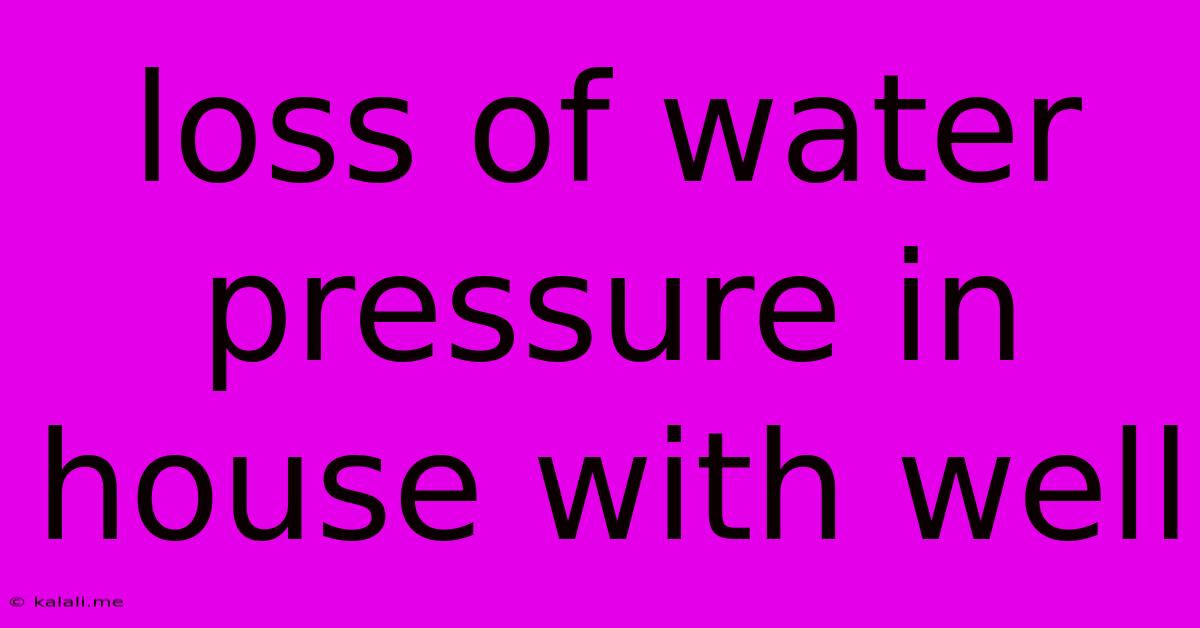Loss Of Water Pressure In House With Well
Kalali
Jun 06, 2025 · 4 min read

Table of Contents
Loss of Water Pressure in Your House: Troubleshooting a Well Water System
Experiencing a sudden drop in water pressure in your home, especially if you're on a well system, can be incredibly frustrating. This article will guide you through common causes of low water pressure from a well, offering troubleshooting tips and potential solutions to restore that crucial water flow. Understanding the underlying issues is key to resolving the problem quickly and efficiently.
Common Culprits Behind Low Well Water Pressure
Several factors can contribute to a decrease in water pressure from your well. Let's explore the most frequent offenders:
-
Low Water Level in the Well: This is often the primary reason for low pressure. Your well's water table may have dropped due to drought, overuse, or seasonal changes. Checking the well's water level is the first diagnostic step.
-
Faulty Well Pump: A malfunctioning well pump is a major suspect. This could involve a worn-out impeller, a broken motor, or a failing pressure switch. Listen for unusual noises—grinding, humming, or clicking—that might indicate pump trouble.
-
Clogged Pipes: Sediment buildup, mineral deposits (scaling), or even physical obstructions within the well pipes or your home's plumbing can restrict water flow, resulting in lower pressure.
-
Leaking Pipes: Hidden leaks in your plumbing system, both inside and outside your home, can significantly reduce water pressure. These leaks can be challenging to detect, requiring careful investigation.
-
Air in the Lines: Air trapped within the plumbing system can interrupt the smooth flow of water, leading to pressure fluctuations or complete loss of pressure.
-
Problems with the Pressure Tank: The pressure tank, a vital component of a well water system, stores water and maintains pressure. A failing pressure tank (leaks, damaged bladder) will lead to inconsistent pressure. This is often accompanied by frequent pump cycling.
-
Defective Pressure Switch: The pressure switch controls the pump's operation based on water pressure levels. A faulty switch might prevent the pump from turning on or cause it to cycle improperly.
Troubleshooting Steps: Identifying the Source of the Problem
Before calling a plumber, systematically check these points:
-
Check the Well Water Level: If you have access to a well casing, visually inspect the water level. A significantly low level points to a depletion of the groundwater supply.
-
Listen to the Well Pump: Pay attention to any unusual sounds. Grinding, squealing, or unusual humming can signal pump failure.
-
Examine the Pressure Gauge: Locate the pressure gauge on your pressure tank. Observe the pressure readings. Inconsistencies or abnormally low readings indicate a problem with the tank or pump.
-
Check for Leaks: Inspect all visible pipes and fittings for leaks. Listen carefully for unusual hissing or dripping sounds.
-
Inspect the Pressure Tank: Look for signs of rust, corrosion, or damage.
-
Check the Pressure Switch: If you're comfortable with basic electrical work, you can test the pressure switch for proper operation. However, if you are not, it's best to call a professional.
-
Run Water at Multiple Fixtures: If the low pressure is isolated to one area, the problem likely lies in the plumbing of that specific zone.
Solutions and Next Steps
Once you've identified the source of the problem, you can take appropriate action:
-
Low Water Level: Contact a well drilling company to assess the well's condition and explore solutions like well deepening or water conservation strategies.
-
Faulty Pump: Repair or replace the well pump. This is a job best left to qualified professionals.
-
Clogged Pipes: Schedule professional plumbing services to clear the blockages.
-
Leaking Pipes: Repair or replace the leaking pipes promptly to prevent further water loss and damage.
-
Air in the Lines: This often resolves itself after running water for some time. If not, a plumber might need to purge the air from the system.
-
Problems with Pressure Tank: Repair or replace the pressure tank.
-
Defective Pressure Switch: Replace the pressure switch.
Addressing low water pressure promptly prevents further damage and ensures a consistent water supply for your home. While some minor issues can be resolved with DIY methods, more complex problems involving the well pump or pressure tank necessitate the expertise of qualified professionals. Remember safety first—if you're unsure about any repair, consult a licensed plumber or well contractor.
Latest Posts
Latest Posts
-
Where Arc Fault Breakers Are Required
Jun 06, 2025
-
Whats Another Word For Vivid Memory
Jun 06, 2025
-
How Do You Get Brake Dust Off Rims
Jun 06, 2025
-
How To Delete An Observance On My Samsung Phone
Jun 06, 2025
-
Is The Signature The Same As A Transaction Id Crypto
Jun 06, 2025
Related Post
Thank you for visiting our website which covers about Loss Of Water Pressure In House With Well . We hope the information provided has been useful to you. Feel free to contact us if you have any questions or need further assistance. See you next time and don't miss to bookmark.